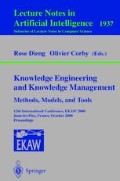Abstract
Guidelines for clinical practice are being introduced in an extensive way in more and more different fields of medicine They have the potential to improve the quality and cost-efficiency of care in a complex health care delivery environment. Computerization may increase the effectiveness of both the information retrieval of guidelines and the management of guideline-based care. The scenario is evolving from stand-alone workstations to telematics applications that enable guidelines development and dissemination. However, such a knowledge sharing requires the definition of formal models for guidelines representation. The models should have a clear semantics in order to avoid ambiguities. The role of ontologies is that of making explicit the conceptualizations behind a model. In this paper we present our library of generic and domain ontologies and point out its role for integrating existing guideline models and defining standard representations. In particular, we stress the distinction -often collapsed within existing guideline models- between the conceptualization of actual procedures, the conceptualization of planning, and the conceptualization behind the diagrammatic representation of plans.
Access this chapter
Tax calculation will be finalised at checkout
Purchases are for personal use only
Preview
Unable to display preview. Download preview PDF.
References
Woolf SH. Practice Guidelines, a New Reality in Medicine: Impact on Patient Care. Arch Intern Med, 1993; 153: 2646–2655.
Grimshaw JM, Russell IT. Effect of Clinical Guidelines on Medical Practice: a Systematic Review of Rigorous Evaluations. Lancet, 1993; 342: 1317–1322.
Clayton PD, Hripcsak G. Decision support in healthcare. Int. J. of Bio-Medical Computing, 1995; 39: 59–66.
Hibble A., Kanka D., Penheon D., Pooles F: Guidelines in general practice: The new Tower of Babel? British Medical Journal, 1998; 317: 862–3.
Vissers MC, Hasman A, vander Linden CJ. Protocol Processing System (ProtoVIEW) to Support Residents at the Emergency Ward. Proc. MIE 94, 1994: 138–143.
Ertle AR, Campbell EM, Hersh WR. Automated Application of Clinical Practice Guidelines for Asthma Management. Proc. AMIA 96, 1996: 552–556.
Gordon CJ et al. Telematics for Clinical Guidelines: A Conceptual Modeling Approach. Proc MIE 97, 1997.
Fox J, Johns N, Rahmanzadeh A. Disseminating Medical Knowledge: The PROforma Approach Artificial Intelligence in Medicine, 1998; 14.
Barnes M, Barnett GO. An Architecture for a Distributed Guideline Server.Proc. 19th SCAMC, 1995: 233–237.
Cimino JJ, Socratous SA. Automated Guidelines Implemented via the World Wide Web.Proc. 19th SCAMC, 1995: 941.
Liem EB, Obeid JS, Shareck EP, Sato L, Greenes RA. Representation of Clinical Practice Guidelines through an Interactive World-Wide-Web Interface.Proc. 19th SCAMC, 1995.
Pisanelli DM, Consorti F, Merialdo P. SMART: A System Supporting Medical Activities in Real Time, Proc. MIE 97, 1997.
Musen MA, Tu SW, Das AK, Shahar Y. EON: A component-based approach to automation of protocol-directed therapy. JAMIA, 1996; 3.
Musen MA, Carlson CW, Fagan LM et al. T-HELPER: Automated support for communitybased clinical research. Proc. 16th SCAMC, 1992.
Gennari JH, Altman RB, Musen MA. Reuse with Protégé-II. Proceedings of the Symposium on Software Reuse, Seattle, 1995.
Steve G, Gangemi A, Pisanelli DM, “Integrating Medical Terminologies with ONIONS Methodology”, in: Info.Modelling and Knowledge Bases VIII, Amsterdam, IOS Press 1998.
Pisanelli DM, Gangemi A, Steve G, “A Medical Ontology Library that integrates the UMLS Metathesaurus”, Proc. AI in Medicine, 1999.
National Library of Medicine, UMLS Knowledge Sources, 1998 edition, available from the NLM, Bethesda, Maryland.
Gruber TR, “A translation approach to portable ontology specification”, Knowledge Acquisition, 5 (2), 1993: 199–220.
MacGregor RM, “A Description Classifier for the Predicate Calculus” Proceedings of AAAI 94, Conference, 1994.
Swartout B, Patil R, Knight K, Russ T, “Toward Distributed Use of Large-Scale Ontologies”, Proceedings of Knowledge Acquisition Workshop, Banff, participants edition, 1996.
Pisanelli DM, Gangemi A, Steve G, “WWW-available Conceptual Integration of Medical Terminologies”, Proc. AMIA 97, 1997.
Guarino N, Carrara M, Giaretta P, An Ontology of Meta-Level Categories. Proc. of KR94. San Mateo, CA, Morgan Kaufmannn, 1994.
Pisanelli DM, Gangemi A, Steve G, “An Ontological Analysis of the UMLS Metathesaurus”, Proc. AMIA 98, 1998.
Shahar Y, Miksch S, Johnson P. The Asgaard project, Artificial Intelligence in Medicine, 1998; 14.
Ohno-Machado L et al. The Guideline Interchange Format, JAMIA, 1998; 6.
Author information
Authors and Affiliations
Editor information
Editors and Affiliations
Rights and permissions
Copyright information
© 2000 Springer-Verlag Berlin Heidelberg
About this paper
Cite this paper
Pisanelli, D.M., Gangemi, A., Steve, G. (2000). The Role of Ontologies for an Effective and Unambiguous Dissemination of Clinical Guidelines. In: Dieng, R., Corby, O. (eds) Knowledge Engineering and Knowledge Management Methods, Models, and Tools. EKAW 2000. Lecture Notes in Computer Science(), vol 1937. Springer, Berlin, Heidelberg. https://doi.org/10.1007/3-540-39967-4_10
Download citation
DOI: https://doi.org/10.1007/3-540-39967-4_10
Published:
Publisher Name: Springer, Berlin, Heidelberg
Print ISBN: 978-3-540-41119-2
Online ISBN: 978-3-540-39967-4
eBook Packages: Springer Book Archive

